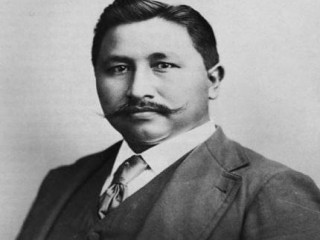
Francis La Flesche biography
Date of birth : -
Date of death : 1932-09-05
Birthplace : United States
Nationality : Native American
Category : Arhitecture and Engineering
Last modified : 2011-05-06
Credited as : Scholar, and writer, Omaha Indian reservation
Francis La Flesche (c. 1857-1932) was one of the first Native Americans to have a career as a research scholar.
Francis La Flesche was one of the first Native Americans to have a noteworthy career as a research scholar and writer of scholarly books. This achievement was all the more remarkable in view of the fact that he had only a few years of primary and secondary education at an Indian mission school, followed many years later by academic training in law while working as a clerk for the federal government in Washington, D.C. With the aid of his extraordinary family and a devoted friend, he remade himself into a widely respected ethnologist.
He was born on the Omaha Indian Reservation, some 70 miles north of the present city of Omaha, Nebraska, the son of Joseph La Flesche (Estamahza or "Iron Eye") and Elizabeth Esau (Ta-in-ne). La Flesche's obituary notice in the American Anthropologist gives his exact date of birth as December 25, 1857, but it is not absolutely certain that even the year is correct because of the absence of official records for that period. His father, of half Omaha and half French blood, was the principal chief of the Omaha tribe, and his mother, a full-blooded Omaha, was the second of at least three wives of Joseph. La Flesche was the half-brother of Indian rights activist Susette La Flesche Tibbles and physician and missionary Susan La Flesche Picotte. He shared in many of the traditional tribal activities and rituals as a child and adolescent, such as participation in several of the last great buffalo hunts before the near extinction of the animals was caused by white hunters. However, his father was determined that all of his children should learn to live in the white man's world. La Flesche attended the Presbyterian mission school on the reservation where he began the study of English, a language of which he was in time to have an impressive command.
La Flesche got his first major exposure to white civilization in 1879, when he and his half-sister Susette served as interpreters for the Ponca Chief Standing Bear on his famous lecture tour to Chicago, Boston, New York, Washington, and other cities. It was at this time that La Flesche first met Alice Cunningham Fletcher, the pioneering ethnologist and crusader for Indian rights, with whom he was to have a close relationship until her death in 1923. He also came to the attention of Samuel Jordan Kirkwood, a United States Senator from Iowa who, when he became Secretary of the Interior in 1881, appointed La Flesche as a clerk in the Office of Indian Affairs. For the rest of his life, Washington, D.C., was his place of residence, though he often spent time working on various Indian reservations and always returned to the Omaha reservation for vacations.
La Flesche was twice married but soon separated from each of his wives. The closest personal, as well as professional, relationship of his life was with Alice Fletcher, a woman some 20 years his senior. She became crippled with rheumatism in the early 1880s and La Flesche became her close associate and interpreter, providing not only physical assistance in her frequent travels to Indian reservations but also assistance in her efforts to improve the condition of the Indians and in her later studies of the life of the Plains Indians. He did much of the research over a period of some 20 years that ultimately resulted in the monumental study The Omaha Tribe, published in 1911 with himself and Fletcher as coauthors. He was particularly skilled at persuading elderly tribal leaders of the Omaha to reveal the words and ceremonies of the ancient tribal rituals, which were rapidly dying out. Alice Fletcher ultimately proposed to legally adopt La Flesche as her son, a plan which fell through only because he did not want to change his surname, as the law required. From 1891 onward, they lived together with another female companion in a house in Washington. La Flesche also studied at the law school of the National University in Washington and was granted a bachelor's degree in law in 1892 and a master's degree in 1893.
In 1900 La Flesche published his first book as sole author: The Middle Five, a charming autobiographical sketch of his school days at the Omaha Indian mission school. It did not sell well at the time but was reprinted in 1963. Following the publication of The Omaha Tribe in 1911, he turned his scholarly research to the Osage tribe, a group closely related to the Omahas. In 1910 he transferred from the Office of Indian Affairs to the Bureau of American Ethnology in the Smithsonian Institution. There he could devote his full time to exhaustive research on the Osage tribe, the first results of which appeared in 1921 in The Osage Tribe: Rite of the Chiefs; Sayings of the Ancient Men. Later products of his studies included a monumental Dictionary of the Osage Language, published in 1932, and War Ceremony and Peace Ceremony of the Osage Indians, published posthumously in 1939.
La Flesche's friend and mentor Alice Fletcher died in 1923. Thus she did not live to see the numerous honors which came to him for his work on the Osages, including membership in the Washington Academy of Sciences and an honorary Doctor of Letters degree from the University of Nebraska in 1926. His own health began to fail in 1927 and he ultimately suffered several paralytic strokes. He died at his younger brother's home on the Omaha Indian reservation near Macy, Nebraska, on September 5, 1932. He was buried on the reservation.
















